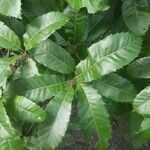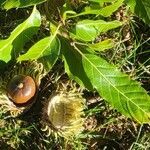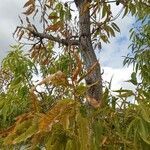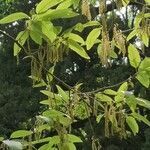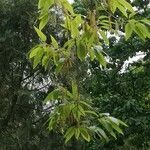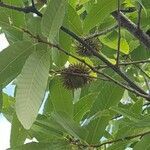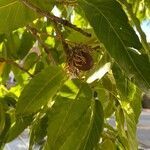Trees to 30 m tall, deciduous. Young branchlets 1.5-2 mm in diam., yellowish gray tomentose, glabrescent, yellowish gray with age, lenticellate; lenticels yellowish brown. Petiole 1-3(-5) cm, tomentose, glabrescent; leaf blade narrowly elliptic-lanceolate, 8-19 × 2-6 cm, concolorous, tomentose, glabrescent or only veins abaxially tomentose with age, base rounded to broadly cuneate, margin with spiniform teeth, apex long acuminate; secondary veins 13-18 on each side of midvein, fusing at serration; tertiary veins abaxially slender, evident, ± parallel. Cupules on previous year’s branchlets, 1 or 2, cupular to discoid, 1.9-4.2 cm in diam. including bracts, enclosing 1/4-1/2 of nut; bracts subulate to ligulate, ca. 1.5 , reflexed, canescent. Nut ovoid to ellipsoid, 1.5-2 × 1.7-2.2 cm, apex impressed; scar ca. 1 cm in diam., raised; stylopodium ca. 4 mm in diam., pale grayish brown sericeous. Fl. Mar-Apr, fr. Sep-Oct of following year.
More
A tree. It grows to 30 m tall. It loses its leaves during the year. The leaf stalk is 1-3 cm long. The leaf blade is narrowly sword shape. It is 8-19 cm long by 2-6 cm wide. It is the same colour on both sides. The base is rounded and there are teeth along the edge. It tapers towards the tip. There are 13-18 secondary veins on each side of the main vein. The fruit are on the previous year's growth. There are 1-2 and they are 1.9-4.2 cm across the cup including the bract. The cup encloses up to half the nut. The nut is 1.5-2 cm long by 1.7-2.2 cm wide.
It is a temperate plant. It is native in regions from the Himalayas to Japan. In China it grows in deciduous forest between 100-2200 m altitude. It suits hardiness zones 5-10. Mt Cootha Botanical Gardens. In Melbourne Botanical Gardens. Temperate. Hobart Botanical Gardens. Kyneton Botanical Gardens.
More
Often forming pure forests or growing with Pinus species, at elevations up to 2,200 metres.
The seeds have been processed into flour during times of food shortage. They are processed into a brown gelatin-like food called acorn milk which is seasoned with chilis, onions and soy sauce and eaten. The seeds have been used as a coffee substitute.
